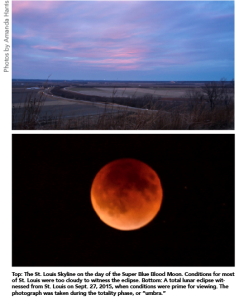Super Blue Blood Moon Eclipse reaches totality early Jan. 31
BY: CHRIS HUTSON
Staff Writer
 2018 is slowly becoming a year of firsts. As of Jan. 31, the United States has already experienced not just its first lunar eclipse of the year but also the first Blue Moon Eclipse since Jul. 31, 2015. Another Blue Moon Eclipse will not occur until Halloween of 2020.
2018 is slowly becoming a year of firsts. As of Jan. 31, the United States has already experienced not just its first lunar eclipse of the year but also the first Blue Moon Eclipse since Jul. 31, 2015. Another Blue Moon Eclipse will not occur until Halloween of 2020.
This eclipse, which occurred early in the morning on Jan. 31, differed greatly from the solar eclipse of the previous summer. Whereas a solar eclipse occurs when the moon passes between the Earth and the sun, a lunar eclipse occurs when the Earth passes between the moon and the sun, and the Earth’s shadow obscures the moon or a portion of it.
Meramec astronomy professor Richard Menendez further explained the differences.
“The penumbra is when the moon is only partially covered and in the shadow. In a solar eclipse penumbra, the Sunlight starts to noticeably dim. In a lunar eclipse, because Earth has an atmosphere it’s nearly impossible for even a pro observer like me to notice any dimming,” said Menendez. “The umbra is when shadow completely covers the sun or Earth; the totality part of the eclipse. The earth’s umbra is much bigger, about three moon widths, 6,000 miles wide, versus the Solar umbra which is about 50 to 70 miles wide.”
According to Schneider, the 2018 lunar eclipse began at 4:51 a.m., which put the moon in the west-northwest sky and close to the horizon. The total eclipse did not begin until two hours later when the moon was very close to the horizon. The moon set at 7:07 a.m. and the entire eclipse was not visible until 10:08 a.m. It was not visible in St. Louis due to cloudy conditions but could be seen from other states including California and Hawaii.
With it having been in the morning, Schneider said the Sky Club, the astronomy club for which he serves as adviser, did not hold any sort of event this year. However, they will be hosting an event for the next lunar eclipse on Jan. 20, 2019, as it will occur in the evening hours and the entire eclipse will be visible.
Solar eclipses require special protective eyewear for viewing, but according to Menendez, there’s no need to worry about such things with lunar eclipses.
“It’s totally safe to view the Lunar eclipse without protection,” said Menendez. “In fact, it’s a bit of a myth that viewing the sun without glasses will damage your eyes. We see the sun all the time when it’s near the horizon and no one goes blind. Think driving near sunset slowdowns on freeways. Now, if you do it 12 hours a day for months at a time it may affect your vision but it’s not the danger it was hyped up to be.”
January’s lunar eclipse was called the Super Blue Blood Moon. However, the moon itself was not blue. Menendez explained the confusion.
“Blue Moon is a phrase referring to the fact that the moon has a 29-day cycle, so if we have a full moon on the first two to three days of a month with 30 or 31 days we can have a second full moon in the same month. This happens about every year or so depending on the calendar.”
Although not as anticipated as the total solar eclipse of the summer, the lunar eclipse was widely covered. The next total lunar eclipse will occur on Jan. 20, 2019, giving people another reason to look to the stars.










